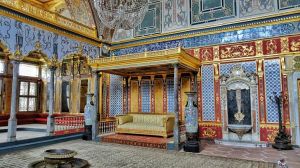Harem
History
The harem of the Turkish Great Sultan, which was in the Topkapı Palace seraglio, typically housed several hundred - at times over a thousand - women including wives. It also housed the Sultan's mother, daughters and other female relatives, as well as eunuchs and slave girls to serve the aforementioned women. During the later periods, the sons of the Sultan also lived in the Harem until they were sixteen, when it might be considered appropriate for them to appear in the public and administrative areas of the palace. The Topkapı Harem was, in some senses, merely the private living quarters of the Sultan and his family, within the palace complex.
It is claimed that harems existed in Persia under the Ancient Achaemenids and later Iranian dynasties (The Sassanid Chosroes II reportedly had a harem of 3,000 wives, as well as 12,000 female slaves) and lasted well into the Qajar dynasty. The women of the royal harem played important though underreported roles in Iranian history, especially during the Iranian Constitutional Revolution. However this claim is disputed by some Persian historians.
Harem is also the usual English translation of the Chinese language term hougong, 後宮—literally meaning "the palaces behind." Hougong are large palaces for the Chinese emperor's consorts, concubines, female attendants and eunuchs. The women who lived in an emperor's hougong sometimes numbered in the thousands.
While some Muslims assert that Islam never proscribes the use of harems, and that they (re)emerged rather as part of Ottoman culture, the institution pre-dates Islam and even Christianity (obviously under other names), The institution of the harem exerted a certain fascination on the European imagination, especially during the Age of Romanticism (see also Orientalism), due in part to the writings of the adventurer Richard Francis Burton. Many westerners imagined a harem as a top-of-the market brothel consisting of many promiscuous women laying around pools with oiled bodies, with the sole purpose of pleasing the powerful man for whom they had given themselves for service. Much of this is recorded in art from that period, usually portraying groups of nude attractive women lounging by spas and pools, congregating nude together, leisurely.
Chat rooms • What links here • Copyright info • Contact information • Category:Root
